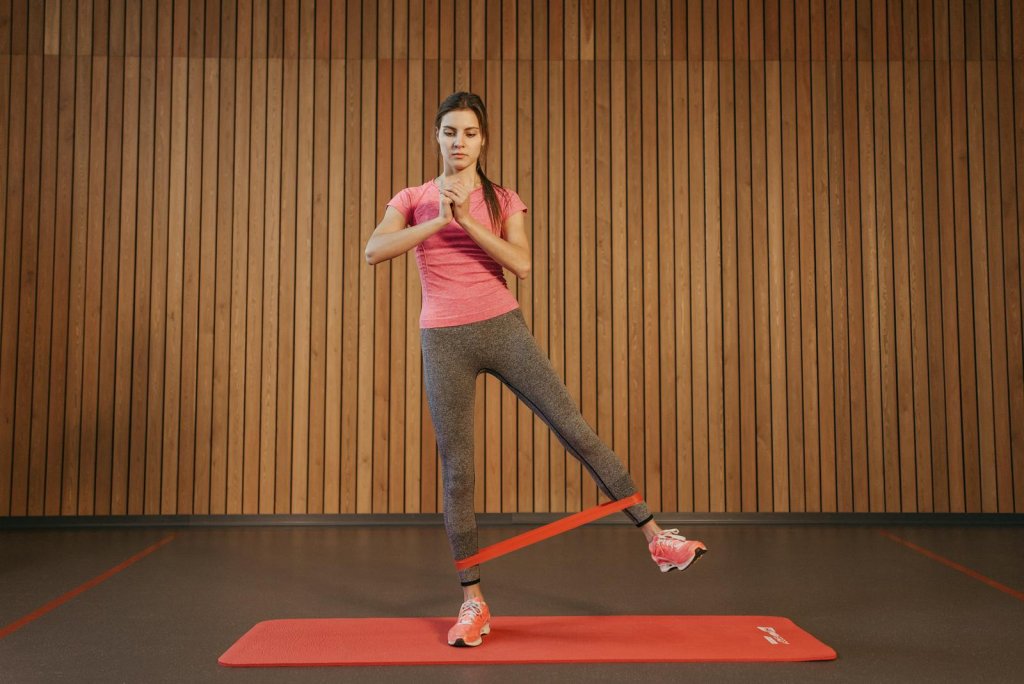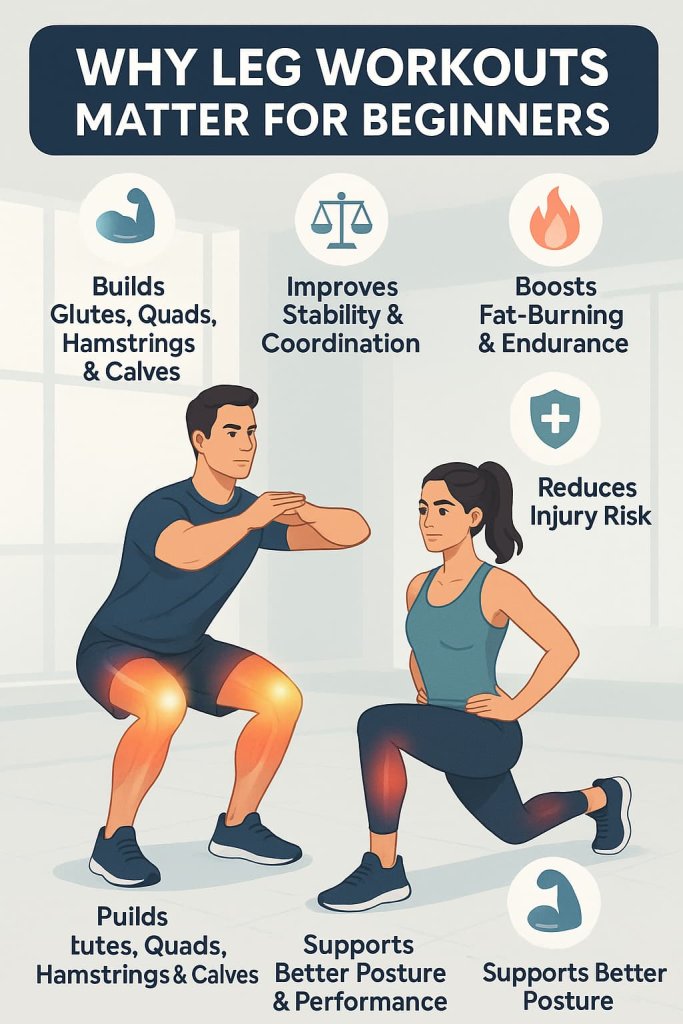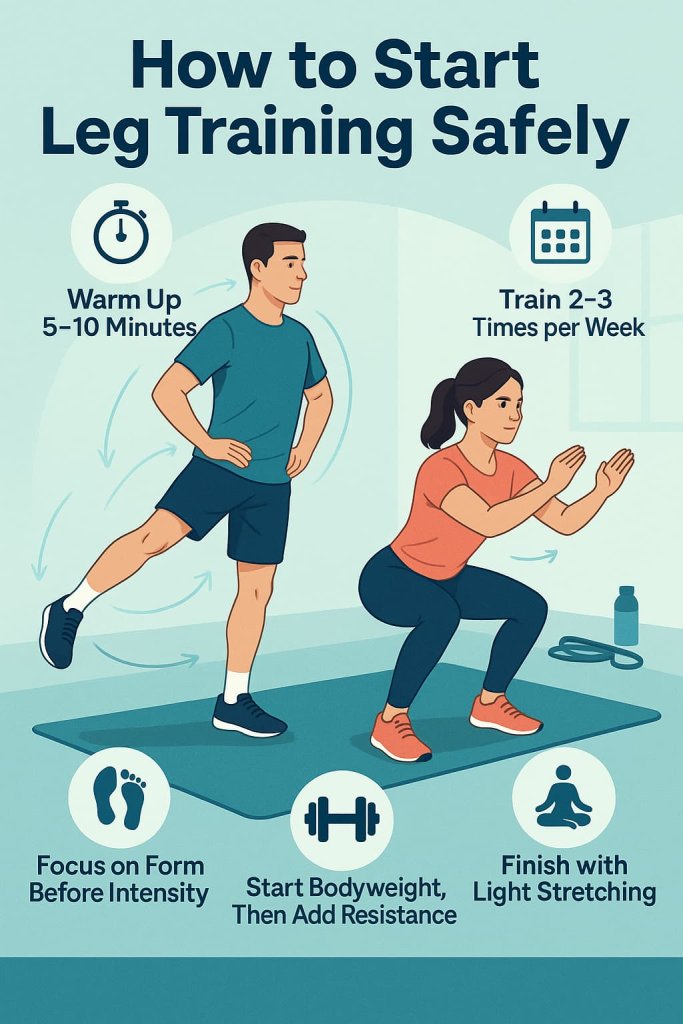The best leg exercises for beginners are squats, lunges, glute bridges, and step-ups — because they build strength, stability, and confidence using your own body weight.
Leg workouts are essential for total-body fitness since your legs house some of the largest muscles in your body. Whether you’re starting your fitness journey or getting back into shape, learning these foundational moves will help you move better, burn more calories, and prevent injury.

In this guide, we’ll cover the 15 best beginner leg exercises — including form tips, muscle focus, and how to progress safely.
Why Leg Workouts Matter for Beginners
According to recent research, training your legs improves balance, supports joint health, boosts metabolism, and enhances daily movement efficiency.
Additional research also notes that leg exercises strengthen bones and help maintain long-term mobility, especially for beginners.
Strong legs don’t just make you look fit — they power every step, squat, and climb you take.

Key benefits of leg training:
- Builds strength in glutes, quads, hamstrings, and calves
- Improves balance and coordination
- Enhances metabolism and fat-burning
- Reduces risk of lower-body injuries
- Supports posture and athletic performance
How to Start Leg Training Safely

- Warm up for 5–10 minutes (e.g., bodyweight squats, leg swings, lunges, hip circles)
- Train 2–3 times per week with at least one rest day between sessions
- Start with bodyweight only, progress to dumbbells or resistance bands
- Focus on form first, then intensity
- Stretch afterward to improve flexibility and recovery
15 Best Leg Exercises for Beginners
These 15 beginner leg exercises build a strong foundation for strength, balance, and mobility — no gym required. Start slow, focus on proper form, and progress gradually to see visible results in just a few weeks.
1. Bodyweight Squat
Why it works:
The squat is the foundation of all leg training. It strengthens the quads, glutes, hamstrings, and core, improving mobility and posture. It also mimics everyday movements like sitting and standing, making it one of the best functional exercises for beginners.
Muscles worked: Quadriceps, glutes, hamstrings, core, calves
How to do it:
- Stand with feet shoulder-width apart and toes slightly out.
- Brace your core, keep your chest tall.
- Push hips back and bend knees to lower into a squat.
- Go as low as your mobility allows (ideally thighs parallel to the floor).
- Drive through heels to return to standing.
Trainer Tip:
Keep your knees aligned with your toes and avoid rounding your lower back. Focus on control rather than speed.
2. Glute Bridge
Why it works:
This simple move activates the glutes and hamstrings while also engaging the core and lower back. It’s excellent for beginners who sit for long hours, as it helps counteract hip tightness and poor posture.
Muscles worked: Glutes, hamstrings, lower back, abs
How to do it:
- Lie flat on your back with knees bent and feet hip-width apart.
- Engage your core and lift hips until shoulders, hips, and knees form a straight line.
- Pause at the top for 1–2 seconds, squeezing your glutes.
- Lower slowly to the starting position.
Trainer Tip:
Avoid arching your lower back — the power should come from your glutes, not your spine.
3. Forward Lunge
Why it works:
This movement builds single-leg strength, improves balance, and trains stability around your knees and hips — key for real-life movement patterns.
Muscles worked: Quads, glutes, hamstrings, calves, core
How to do it:
- Stand tall with feet hip-width apart.
- Step one foot forward and lower both knees to about 90 degrees.
- Keep your chest upright and back straight.
- Push through your front heel to return to the starting position.
- Switch legs each rep.
Trainer Tip:
Shorten your stride slightly if you feel knee discomfort. Focus on controlled movement, not speed.
4. Step-Up
Why it works:
Step-ups strengthen the quads, glutes, and hamstrings while improving balance and coordination. It’s a low-impact way to build power, mimicking stair climbing.
Muscles worked: Glutes, quads, hamstrings, calves
How to do it:
- Stand facing a sturdy bench or step (knee height or lower).
- Place one foot on top and push through the heel to lift your body.
- Bring the trailing leg up without pushing off too much.
- Step back down under control and repeat.
Trainer Tip:
Start with a low step to master balance before progressing to higher platforms or adding weights.
5. Wall Sit
Why it works:
An excellent isometric exercise for building endurance in your thighs and glutes. It also strengthens stabilizing muscles around the knees.
Muscles worked: Quads, glutes, hamstrings, core
How to do it:
- Stand with your back against a wall.
- Slide down until thighs are parallel to the floor, knees directly above ankles.
- Hold for 20–60 seconds while keeping your abs tight.
Trainer Tip:
Keep your back flat against the wall. For more challenge, hold light weights or extend one leg for a single-leg wall sit.
6. Calf Raise
Why it works:
Strengthens the calf muscles for improved ankle stability, balance, and lower-leg endurance — crucial for running, walking, and jumping.
Muscles worked: Gastrocnemius, soleus, Achilles stabilizers
How to do it:
- Stand with feet hip-width apart, holding a wall or chair for balance.
- Rise onto your toes and hold for a second.
- Lower your heels slowly to the floor.
Trainer Tip:
For more range, perform on a stair edge with heels dropping below the step.
7. Side Lunge
Why it works:
Trains inner and outer thigh muscles while improving hip mobility and lateral movement control — often overlooked in forward-only exercises.
Muscles worked: Glutes, adductors, abductors, quads
How to do it:
- Stand tall with feet wide apart.
- Step to the right, bending your right knee while keeping the left leg straight.
- Push off your right heel to return to center.
- Repeat on the other side.
Trainer Tip:
Keep your chest up and weight in your heel. Avoid letting the knee collapse inward.
8. Bulgarian Split Squat
Why it works:
This advanced beginner move builds leg strength, balance, and stability while improving coordination and hip flexibility.
Muscles worked: Quads, glutes, hamstrings, core
How to do it:
- Stand about two feet in front of a bench.
- Place one foot behind you on the bench.
- Lower your hips until your front thigh is parallel to the floor.
- Push through the front heel to stand up.
Trainer Tip:
Start without weights until you master balance. Keep your torso upright and core tight throughout.
9. Hip Thrust
Why it works:
Targets the glutes more effectively than most bodyweight moves and supports posture by strengthening the posterior chain.
Muscles worked: Glutes (maximus and medius), hamstrings, lower back
How to do it:
- Sit with your upper back against a bench and knees bent.
- Place feet flat, shoulder-width apart.
- Drive hips upward until your torso forms a straight line.
- Lower under control.
Trainer Tip:
Pause and squeeze at the top for 2 seconds for maximum glute activation.
10. Reverse Lunge
Why it works:
Gentler on knees than forward lunges, it develops balance and hip stability while engaging the glutes and hamstrings.
Muscles worked: Glutes, hamstrings, quads, calves
How to do it:
- Stand upright with feet hip-width apart.
- Step one foot backward and lower both knees to 90 degrees.
- Push through the front heel to return.
- Switch legs each rep.
Trainer Tip:
Keep your weight in the front heel and avoid leaning forward excessively.
11. Sumo Squat
Why it works:
A wider stance squat variation that emphasizes the inner thighs, glutes, and hip adductors, improving hip flexibility and stability.
Muscles worked: Glutes, adductors, quads, hamstrings
How to do it:
- Stand with feet wider than shoulders and toes angled out.
- Push hips back and lower down, keeping your torso tall.
- Drive through heels to stand.
Trainer Tip:
Keep knees tracking over toes and avoid leaning forward. Engage your core for stability.
12. Chair Squat
Why it works:
Ideal for beginners to master proper squat depth and balance. It builds confidence and coordination while reinforcing safe technique.
Muscles worked: Quads, glutes, hamstrings
How to do it:
- Stand in front of a chair with feet hip-width apart.
- Lower hips back slowly until glutes lightly touch the chair.
- Drive up through heels to stand tall.
Trainer Tip:
Don’t collapse into the seat — keep tension in your legs throughout the movement.
13. Standing Kickback
Why it works:
Isolates and strengthens the glutes while enhancing hip extension control, improving posture and movement efficiency.
Muscles worked: Gluteus maximus, hamstrings, core
How to do it:
- Hold a wall or chair for support.
- Shift weight onto one leg and extend the other leg straight back.
- Squeeze the glute at the top, then return slowly.
Trainer Tip:
Avoid arching your back — keep movement slow and controlled for best muscle activation.
14. Lateral Band Walk
Why it works:
Activates the hip abductors and outer glutes to improve knee stability and prevent common lower-body imbalances.
Muscles worked: Gluteus medius, abductors, tensor fasciae latae
How to do it:
- Place a resistance band just above your knees.
- Slightly bend knees and step sideways, keeping constant tension on the band.
- Take 8–10 steps in each direction.
Trainer Tip:
Maintain a low stance throughout and avoid letting knees cave inward.
15. Hamstring Curl (with Stability Ball)
Why it works:
This movement targets the hamstrings and glutes while challenging your balance and core — excellent for joint stability.
Muscles worked: Hamstrings, glutes, core
How to do it:
- Lie on your back with heels on a stability ball.
- Lift hips and roll the ball toward you by bending knees.
- Slowly extend legs back to starting position.
Trainer Tip:
Keep hips lifted throughout the movement and move slowly to maximize hamstring engagement.
Beginner Leg Workout Routine Example
| Exercise | Sets | Reps | Rest |
|---|---|---|---|
| Bodyweight Squat | 3 | 12–15 | 60 sec |
| Glute Bridge | 3 | 15 | 45 sec |
| Step-Up | 3 | 10 per leg | 60 sec |
| Wall Sit | 3 | 30 sec | 45 sec |
| Calf Raise | 3 | 15–20 | 30 sec |
Tip: Perform this routine 2–3 times per week. Gradually add resistance bands or light dumbbells as you progress.
Common Beginner Mistakes
- Rushing through reps instead of controlling movement
- Allowing knees to collapse inward
- Skipping warm-ups and cool-downs
- Training inconsistently
- Using poor form due to fatigue
Correct these early for better results and fewer injuries.
FAQs About Beginner Leg Exercises
1. How often should beginners train legs?
2–3 times weekly with a rest day between sessions for recovery and growth.
2. Can I build leg muscle without equipment?
Yes — bodyweight moves like squats, lunges, and bridges are highly effective.
3. What’s the best warm-up for leg day?
Dynamic stretches: leg swings, hip circles, lunges, and light cardio for 5–10 minutes.
4. Should I do cardio before or after leg workouts?
If your goal is strength, do cardio after. For endurance, warm up with light cardio first.
5. How long until I see results?
Most beginners notice improvements in 4–6 weeks with consistent training and good nutrition.
6. Are leg workouts good for fat loss?
Yes — larger muscles burn more calories, even at rest.
7. What if I have knee pain?
Start with low-impact moves like glute bridges, wall sits, or step-ups, and consult a professional if pain persists.
Conclusion
Leg workouts are the foundation of a strong, balanced, and functional body. Start simple, focus on form, and stay consistent. With these 15 beginner exercises, you’ll build confidence, boost your strength, and set the stage for long-term progress — no gym required.
Ready to start? Commit to two leg sessions this week and see how quickly your strength improves!
References
- CDC — Physical Activity Guidelines for Adults — https://www.cdc.gov/physical-activity-basics/guidelines/adults.html
- ACSM — Physical Activity Guidelines (Resource Hub) — https://www.acsm.org/education-resources/trending-topics-resources/physical-activity-guidelines/
- ACE — Resistance Training Workouts for Beginners — https://www.acefitness.org/resources/everyone/blog/8650/resistance-training-workouts-for-beginners/
